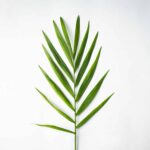The Phoenix Palm, also known as the Date Palm, is a popular plant for those looking to add some tropical flair to their indoor spaces. With its distinctive long fronds and ability to thrive in low light conditions, the Phoenix Palm is an excellent choice for anyone looking to bring a touch of greenery into their home or office environment.
However, growing Phoenix Palms indoors can be a challenging task for even the most experienced gardeners. This article aims to provide expert guidance on cultivating healthy and vibrant Phoenix Palms in indoor environments. From selecting the right potting soil and lighting conditions to monitoring humidity levels, this article will cover all the essential steps needed to ensure your Phoenix Palm thrives and grows into a beautiful addition to your space.
Understanding The Phoenix Palm
The Phoenix Palm, also known as the Date Palm, is a symbol of resilience and endurance. It thrives in harsh desert conditions, standing tall despite the scorching heat and dryness. Growing conditions for this palm tree can vary greatly, but it typically prefers warm temperatures and plenty of sunlight. Careful attention to watering and fertilizing is essential to ensure proper growth.
When growing Phoenix Palms indoors, replicating their natural habitat is crucial. The ideal temperature range for these palms is between 60-85°F (15-29°C). Keep them away from cold drafts or air conditioning vents that can harm their delicate fronds. They require at least 6 hours of direct sunlight each day, so place them near a window that receives plenty of light. If this isn’t possible, consider using artificial grow lights.
Maintaining proper moisture levels in the soil is vital for healthy Phoenix Palm growth. Overwatering can lead to root rot, while underwatering can cause wilting and yellowing leaves. Water your palms thoroughly once a week or when the top inch of soil feels dry to the touch. Fertilize every two months with a balanced liquid fertilizer to promote strong growth and vibrant green foliage. With proper care tips in mind, you can enjoy a thriving indoor garden filled with beautiful Phoenix Palms! As we move on to choosing the right pot, let’s first take a look at some important factors to keep in mind.
Choosing The Right Pot
Now that we understand the basics of the Phoenix Palm, it’s important to choose the right pot for optimal growth. When selecting a pot, size and material are crucial factors to consider. The pot should be large enough to accommodate the roots and provide ample space for growth. As a general rule of thumb, the diameter of the pot should be 2 inches larger than the root ball.
In addition to size, material is also important. Clay pots are ideal as they allow for proper airflow and drainage. Plastic pots may retain too much moisture and cause root rot if not monitored closely. It’s important to note that regardless of material, proper drainage holes must be present in the bottom of the pot.
When choosing a pot, aesthetics should also be considered. The pot should complement your indoor decor while providing an appropriate environment for your Phoenix Palm to thrive. Once you have selected the perfect pot, it’s time to consider placement.
Finding the perfect spot is essential for indoor Phoenix Palm growth. Avoid placing your palm near drafts or direct sunlight as this can cause damage or stunted growth. A bright room with indirect sunlight is ideal. By following these tips for selecting a pot and finding the perfect placement, your Phoenix Palm will have everything it needs to flourish indoors. Next up: selecting the perfect soil for optimal growth.
Selecting The Perfect Soil
As the old saying goes, “you reap what you sow.” The soil composition is one of the most crucial factors in growing healthy indoor phoenix palms. It must provide a balanced mix of nutrients, moisture retention, and proper drainage.
When selecting soil for your date palm, avoid using garden soil or potting soil intended for outdoor plants. These types of soil are too heavy and may not provide adequate drainage. Instead, choose a high-quality potting mix that is specifically formulated for indoor palms. A good potting mix should contain peat moss or coconut coir to retain moisture, perlite or vermiculite to aid in drainage, and added nutrients such as nitrogen, phosphorus, and potassium.
Pot size also plays a critical role in ensuring healthy growth for your indoor date palm. Phoenix palms have an extensive root system that requires ample space to grow. Choose a pot that is at least 2-3 inches larger in diameter than the current root ball. A larger pot allows for better air circulation around the roots and prevents overcrowding. Additionally, it provides more room for water absorption and reduces the risk of root rot.
To ensure optimal growth and health of your indoor phoenix palm, it is essential to provide adequate drainage. Inadequate drainage can lead to waterlogged soil, which can cause root rot and other diseases that can harm your plant’s health. In the subsequent section, we will discuss how to provide proper drainage for your potted plant without compromising its aesthetics.
Providing Adequate Drainage
When growing phoenix palms indoors, selecting appropriately sized containers with adequate drainage holes is critical for successful cultivation. Containers should be selected based on the size of the palm and the depth of soil needed to adequately cover the root ball. Proper drainage holes, typically found near the base of the container, help to ensure excess water can leave the container without pooling or sitting at the roots of the palm. Additionally, it is necessary to include a layer of drainage material such as gravel or pebbles at the bottom of the container to further improve drainage.
Selecting Containers
When growing phoenix palms indoors, selecting the right container is crucial for their growth and survival. Container materials play a significant role in providing adequate drainage to ensure the soil stays moist but not waterlogged. Porous containers made of clay or terracotta are ideal choices as they allow air to reach the roots and excess water to evaporate quickly.
Proper drainage techniques are equally important when choosing a container for your indoor date palm. To prevent water from pooling at the bottom, it’s essential to have drainage holes at the bottom of the container. The number and size of holes depend on the container’s size and material, with larger pots requiring more drainage holes. Additionally, placing a layer of pebbles or gravel at the bottom of the pot can further aid in drainage and prevent root rot.
When selecting a container, it’s also important to consider its size relative to your plant’s current size and expected growth rate. A container that is too small can restrict root growth and limit the plant’s potential, while one that is too large can cause soil moisture problems due to inadequate root development. Ultimately, choosing an appropriate container material and employing proper drainage techniques will help ensure a healthy growth environment for your indoor date palm.
Drainage Holes
Proper drainage is essential for the growth and survival of indoor date palms. As an expert on phoenix palm cultivation, it’s my duty to emphasize the importance of having drainage holes in the container. These holes serve as a passage for excess water to escape and prevent waterlogging that can lead to root rot. Hence, it’s crucial to ensure that the pot has enough drainage holes at its bottom.
The maintenance of these drainage holes is equally important. Over time, soil particles and debris can clog the holes, hindering proper drainage. Therefore, it’s necessary to check periodically if the drainage holes are clear and unclogged. This can be done by inspecting the pot’s base or running water through its soil to see if it drains adequately. Neglecting this aspect can have detrimental effects on your indoor date palm’s health.
In conclusion, adequate drainage is vital for your indoor date palm’s well-being, and maintaining its drainage holes is crucial in achieving this goal. As a responsible cultivator of phoenix palms, one must understand that these plants require a conducive environment to thrive, which includes appropriate container selection with proper drainage techniques in place. By implementing these measures, you can ensure your plant has sufficient moisture while avoiding overwatering that could harm its growth and development.
Watering Your Phoenix Palm
Watering your indoor phoenix palm is an essential aspect of its care routine. Overwatering or underwatering the plant can be detrimental to its overall health and appearance. Therefore, it is crucial to establish a regular watering schedule to keep your plant healthy.
The watering frequency of your phoenix palm depends on several factors such as the size of the pot, humidity levels in the air, and temperature. As a general rule, it’s best to water your plant when the soil has become slightly dry but not completely dry. Checking the moisture level of the soil with a finger or moisture meter can help determine whether it needs watering or not.
Maintaining proper soil moisture is vital for your phoenix palm’s growth and survival. It is recommended to use a well-draining potting mix that allows excess water to drain out quickly, preventing root rot. To ensure sufficient drainage, consider adding perlite or sand to the soil mix. Overwatering can lead to yellow leaves and root rot, while underwatering can cause wilting and stunted growth in your plant.
Fertilizing Your Plant
As we have learned in the previous section, watering your phoenix palm is crucial for its growth and health. However, it is not enough to just water your plant regularly. Fertilizing your indoor date palm is equally important to keep it thriving.
Using organic fertilizers is a great way to nourish your phoenix palm without exposing it to harmful chemicals. These fertilizers are made from natural materials such as bone meal, blood meal, and composted manure. They also contain essential nutrients like nitrogen, phosphorus, and potassium that are necessary for plant growth.
Understanding fertilizer ratios is also important when fertilizing your phoenix palm. The three numbers on a fertilizer label represent the percentage by weight of nitrogen, phosphorus, and potassium respectively. For example, a fertilizer labeled 10-5-5 contains 10% nitrogen, 5% phosphorus, and 5% potassium. It’s important to choose the right ratio based on the needs of your specific plant species.
In order to ensure that your indoor date palm remains healthy and strong over time, fertilizing it with organic fertilizers with the appropriate nutrient ratios is essential. But there are other factors that can impact its growth too – controlling humidity levels is one of them. Let’s explore this further in the next section.
Controlling Humidity Levels
Humidity monitors are an essential tool for monitoring indoor humidity levels for the cultivation of phoenix palms. Humidifiers and dehumidifiers are often used to actively control the humidity levels. Ventilation, air conditioning, water misters, evaporation pools, trays of water, and plants can all help create a suitable environment for phoenix palm cultivation indoors. Soil mix, pots, climates, humid areas, and dry areas also play an important role in determining the success of controlling humidity levels for indoor phoenix palm cultivation.
Humidity Monitors
As an expert in cultivating phoenix palms indoors, I highly recommend using humidity monitors to help control the moisture levels in the environment. These devices offer a range of benefits, including providing accurate and real-time readings of the humidity levels, which can help prevent over or under-watering of the plants. Additionally, they can help identify areas that may have higher or lower humidity levels than others, allowing for targeted adjustments to be made.
To ensure that your humidity monitor is giving you accurate readings, it needs to be calibrated regularly. This process involves comparing the readings on your monitor with those from a reference instrument such as a hygrometer. If there are any discrepancies between the two measurements, adjustments need to be made to bring the monitor back into alignment. By calibrating your humidity monitor on a regular basis, you can trust that you are getting reliable information about the moisture content in your indoor gardening environment.
In summary, using a humidity monitor is an essential tool for successfully growing phoenix palms indoors. These devices offer numerous benefits such as real-time monitoring and identification of areas with differing moisture levels. To ensure they are functioning correctly and giving accurate readings, it is important to calibrate them regularly using a reference instrument like a hygrometer. Incorporating these steps into your indoor gardening routine will help promote healthy and thriving phoenix palms.
Humidifiers
Maintaining the ideal humidity levels is crucial to ensure the optimal growth of indoor phoenix palms. While using a humidity monitor helps in monitoring and regulating moisture content, incorporating a humidifier can offer additional benefits. Humidifiers add moisture to the air, which can alleviate dryness and maintain adequate humidity levels for your plants. They also help prevent issues such as leaf browning, wilting, and dropping.
When choosing a humidifier for growing phoenix palms indoors, it is essential to consider several factors. The best humidifiers for these plants would be those that produce cool mist or ultrasonic humidifiers that release a fine mist into the air. These types of humidifiers are more effective than warm mist or steam models because they do not affect room temperature and do not pose any risk of burning your plants. Additionally, it is recommended to select a model with adjustable settings to regulate humidity levels accurately.
Besides plant health benefits, adding a humidifier to your indoor gardening routine can have positive effects on human health too. Properly moisturized air can reduce respiratory problems such as allergies, asthma, and sinusitis. It also promotes healthy skin by preventing dryness and irritation. By incorporating a high-quality humidifier into your indoor gardening practices, you are promoting both plant growth and overall well-being for yourself and others in your home or office space.
Managing Temperature Fluctuations
Maintaining an appropriate temperature is crucial for growing indoor phoenix palms. As tropical plants, they thrive in warm and humid conditions that mimic their natural environment. When the temperature drops below 60°F, they may suffer from cold stress and become susceptible to diseases. On the other hand, when the temperature rises above 80°F, they may experience heat stress and exhibit symptoms such as wilting or yellowing leaves.
To manage temperature fluctuations, it’s essential to set the thermostat at a consistent level that suits the plant’s needs. During the day, aim for a temperature range between 70-80°F and lower it slightly at night to around 60-65°F. Keep in mind that drastic changes in temperature can shock the plant and cause damage, so avoid sudden adjustments. Additionally, adjust thermostat settings according to seasonal changes to ensure that your phoenix palm receives optimal growing conditions.
When managing temperature fluctuations for indoor phoenix palms, consider investing in equipment such as a thermometer or hygrometer to monitor both temperature and humidity levels accurately. These tools will help you make informed decisions about adjusting thermostat settings based on changes in environmental conditions. By providing consistent temperatures within an appropriate range throughout the year, you’ll create a stable growing environment that supports healthy growth and development of your indoor date palm.
Maintaining proper temperatures is only one aspect of growing healthy indoor phoenix palms; providing adequate lighting is just as crucial. By ensuring that your plant receives sufficient light under suitable conditions, you’ll promote photosynthesis and encourage strong growth.
Providing Adequate Lighting
To ensure healthy growth of indoor date palms or phoenix palms, providing adequate lighting is crucial. While natural light is ideal, it may not always be available in sufficient amounts. In such cases, using grow lights can be an effective alternative.
There are various types of grow lights that can be used for indoor palm trees. LED (light-emitting diode) grow lights are energy-efficient and long-lasting, making them a popular choice among growers. Fluorescent grow lights are also widely used as they produce a wider spectrum of light, which promotes better growth and development. However, they do require replacement every 6-12 months. High-intensity discharge (HID) lights are another option that provide high levels of light intensity but consume more energy and generate more heat.
While using grow lights has its benefits, there are also drawbacks to consider. Overexposure to artificial light can harm the plant’s health and growth. It is important to follow the recommended usage guidelines for each type of grow light to prevent damage to the plant. Additionally, investing in quality grow lights can be expensive and may require additional maintenance costs such as bulb replacement.
Providing adequate lighting is essential for indoor date palm cultivation. Grow lights can offer an effective solution when natural light is limited or unavailable. However, it is important to carefully consider the type of grow light used and proper usage guidelines to avoid any negative effects on plant health and growth. The next step in ensuring optimal plant health is preventing pest infestations through proactive measures such as regular cleaning and inspection of the plant’s environment.
Preventing Pest Infestations
- Monitoring the environment is essential for preventing pest infestations when growing Phoenix Palms indoors.
- Appropriate humidity, temperature and ventilation levels should be maintained in order to reduce the risk of infestations.
- Natural repellents, such as neem oil and garlic, can be used to create an environment that is unsuitable for pests.
- Keeping the palms healthy with a balanced fertilization program and pruning regularly can also help reduce pest infestations.
Monitor Environment
Maintaining a healthy environment is crucial to the growth of indoor date palms. As an expert in phoenix palm cultivation, I understand the importance of monitoring the temperature and humidity levels in your home. These factors can greatly affect the health and growth of your plants.
To prevent pest infestations, it’s essential to control the humidity level in your indoor garden. High humidity levels can lead to mold and fungus growth, which can attract pests like spider mites and thrips. You should aim for a humidity level between 50-60% for optimal growth. Investing in a hygrometer is an excellent way to monitor the humidity level in your home.
Temperature monitoring is another critical factor when it comes to preventing pest infestations. Phoenix palms thrive in warm temperatures ranging from 70-80°F during the day and 60-65°F at night. Pests are more likely to breed and multiply in cooler temperatures, so make sure to keep your indoor garden within these temperature ranges. By keeping a close eye on both temperature and humidity levels, you can create an environment that promotes healthy plant growth while deterring pests from invading your space.
In conclusion, monitoring your indoor environment is essential when it comes to preventing pest infestations in your phoenix palms. With proper humidity control and temperature monitoring, you can create an ideal growing environment for your plants, while also ensuring that they remain pest-free. So invest some time into observing these factors closely; it will pay off with healthy, thriving plants!
Natural Repellents
As an expert in phoenix palm cultivation, I understand the challenges of dealing with pest infestations. While it is essential to monitor the temperature and humidity levels in your indoor garden, there are other ways to prevent pests from invading your space. One effective method is using DIY natural repellents that can create a pest-free environment without harming your plants or pets.
DIY natural repellents are an excellent solution for those who prefer using non-toxic methods to keep their plants safe from harmful insects. There are many recipes available that use everyday household ingredients such as garlic, onion, vinegar, and essential oils. These natural repellents work by emitting strong scents that deter pests from coming near your plants.
Creating a pest-free environment using DIY natural repellents requires some experimentation and patience. You may need to try several recipes before finding one that works best for your indoor garden. However, once you find the right combination of ingredients, you’ll have a potent tool in preventing pest infestations in your phoenix palms. By incorporating these natural remedies into your routine, you can ensure that your indoor garden remains healthy and thriving for years to come.
Pruning Your Phoenix Palm
Like a sculptor shaping a block of marble, pruning your phoenix palm allows you to shape and direct its growth. Pruning techniques, such as removing yellow or brown fronds, can improve the plant’s appearance and health. Additionally, pruning can help prevent potential safety hazards from falling fronds.
To maintain a healthy phoenix palm, it is important to establish a regular maintenance schedule for pruning. As a general rule of thumb, remove any fronds that are more than halfway brown or yellow. It is also recommended to prune away any dead or damaged fronds as soon as possible to prevent decay and disease from spreading.
Proper pruning techniques involve using sharp, clean tools and making precise cuts at the base of each frond stem. Avoid cutting too close to the trunk or leaving stubs that can invite pests and disease. By establishing a consistent maintenance schedule and using proper pruning techniques, you can ensure your indoor date palm is healthy and thriving for years to come.
As your phoenix palm continues to grow, it may eventually outgrow its current pot. In the next section, we will discuss repotting your plant to accommodate its growing needs without causing harm or stress.
Repotting Your Plant
- When selecting a pot for a phoenix palm, it is important to consider the size and material of the pot.
- The soil should be a loamy, well-draining mixture to ensure the palm will have adequate drainage.
- The soil should also be amended with organic material to provide additional nutrients.
- The repotted palm should be watered thoroughly to ensure that the soil is evenly moist.
- After watering, the soil should be monitored to make sure that it is not too wet or too dry.
- Every couple of months, a liquid fertilizer can be applied to provide additional nutrients for the phoenix palm.
Choosing A Pot
When repotting your indoor date palm, choosing the right pot is crucial to ensure its healthy growth. Decorative options can be tempting, but it’s important to prioritize function over form. The ideal pot should have drainage holes to prevent waterlogging and promote proper root development. Additionally, it must be large enough to accommodate the palm’s expanding root system.
Size considerations are also critical when selecting a pot for your phoenix palm. The pot should be at least 2 inches larger in diameter than the previous one to provide ample space for the roots to grow. However, avoid going too big as an excessively large pot can hold excess water leading to root rot or even cause your palm tree to wilt. The right size of the pot will ensure that your indoor date palm has enough room for its roots, allowing it to thrive.
When choosing a decorative option for your indoor date palm’s new home, keep in mind that aesthetics shouldn’t compromise functionality. Selecting a pot with intricate designs may seem appealing but make sure it doesn’t detract from the health of your plant. Ultimately, prioritizing size and drainage over design elements will help you find the perfect pot for your phoenix palm’s healthy growth and longevity.
Preparing The Soil
As an expert in indoor date palm cultivation, it’s imperative to prepare the soil properly when repotting your plant. The right soil condition will provide essential nutrients and support for your phoenix palm’s root system, allowing it to flourish. Composting materials such as peat moss, coconut coir, and vermiculite are excellent options for improving the soil quality. These materials help retain moisture and improve drainage while providing additional organic matter for the roots.
In addition to composting materials, organic fertilizers are also essential in preparing the soil for repotting your indoor date palm. Fertilizers containing nitrogen, phosphorus, and potassium are vital for healthy growth and development of your phoenix palm. It’s crucial to avoid over-fertilization, which can cause salt buildup and damage or even kill your plant. A good rule of thumb is to use a slow-release fertilizer that can provide nutrients gradually over time.
Lastly, ensure that the soil is well-aerated by mixing it thoroughly before adding it to the pot. This will prevent any air pockets from forming within the soil that could potentially cause root rot or stunted growth. Properly preparing the soil with composting material and organic fertilizers will provide a healthy foundation for your indoor date palm to thrive in its new environment. Remember that taking care of your plant means prioritizing its health over aesthetics or convenience – this mindset will ultimately lead to a long-lasting and beautiful phoenix palm tree in your home!
Watering The Plant
Repotting your indoor date palm is an essential process that involves several crucial steps to ensure the health and longevity of your plant. In addition to preparing the soil, it’s vital to understand how to water your phoenix palm correctly. Watering frequency and soil moisture levels are critical factors that can significantly impact the growth and development of your plant.
When repotting your indoor date palm, it’s crucial to establish a consistent watering schedule. Phoenix palms thrive in soil that is consistently moist but not waterlogged. Overwatering can lead to root rot and other fungal diseases, while underwatering can cause stunted growth and wilting leaves. The frequency of watering will depend on various factors such as the size of the pot, humidity levels, and ambient temperature.
To determine when it’s time to water your indoor date palm after repotting, check the soil moisture level by inserting your finger about an inch into the soil. If the top layer feels dry, it’s time to water your plant thoroughly until you see water draining from the bottom of the pot. However, if the soil feels damp, wait a few more days before checking again. Remember that maintaining proper soil moisture levels is key to ensuring optimal growth and health for your phoenix palm!
Propagating Your Phoenix Palm
Growing a beautiful phoenix palm indoors is a rewarding experience, but propagating one can be even more satisfying. Propagation can be accomplished through either germinating seeds or air layering. Germinating seeds requires patience and time, as it may take several weeks for the seedlings to emerge. The process involves soaking the seeds in warm water for 24 hours before planting them in a container filled with moist soil. Keep the container in a warm location and make sure to keep the soil moist until the seedlings are established.
Air layering is another method of propagation that can yield quicker results, but it requires some knowledge and skill. It involves making a small incision on the stem, wrapping it with damp sphagnum moss, and then covering it with plastic wrap to create a humid environment. After several weeks, roots will begin to grow from the incision site, and once they have developed enough, you can cut off the newly rooted section of stem and plant it in its own container.
Propagating your phoenix palm can be an excellent way to expand your indoor garden or share your love of plants with others. Whether you choose to germinate seeds or use air layering techniques, both methods require careful attention to detail and patience. Once you have successfully propagated your phoenix palm, you will have created a new plant that will bring beauty and joy into your home for years to come.
Transition: Now that you know how to propagate your phoenix palm successfully let’s move on to troubleshooting common problems that may arise during cultivation.
Troubleshooting Common Problems
After successfully propagating your phoenix palm, the next step is to ensure that it grows properly indoors. Indoor cultivation of date palms requires attention to detail and diligent care. As an indoor date palm cultivation expert, I recommend taking note of common problems that may arise during the growth process and their corresponding solutions.
One of the most common issues in growing phoenix palms indoors is overwatering. This can lead to root rot, which can ultimately kill the plant. To avoid this problem, make sure to use well-draining soil and only water when the top inch of soil feels dry to the touch. Another issue that may arise is insufficient light. Phoenix palms require bright, indirect sunlight for several hours a day. If you notice yellowing or browning leaves, it may be time to move your plant closer to a window or invest in a grow light.
If you have tried these common solutions and are still experiencing problems with your phoenix palm, it may be time to seek professional help. A certified arborist or horticulturist can assess your plant’s health and provide recommendations on how best to care for it. Additionally, they can identify any potential pests or diseases that may be affecting your plant and offer effective treatment options.
By following these tips for caring for your phoenix palm indoors, you will soon be able to enjoy the fruits of your labor. With proper care, these plants can live for decades and continue to thrive in your home environment. Remember, preventative measures such as regular watering and monitoring for pests are key in maintaining a healthy and vibrant indoor phoenix palm.
Enjoying The Fruits Of Your Labor
Harvesting techniques for indoor date palms require patience and a keen eye for the fruit’s ripeness. The first step in harvesting is to determine if the fruit is mature enough to be harvested. This can be done by examining the color of the fruit and testing its firmness. If the fruit is still green, it should not be harvested as it is not yet ripe. However, if the fruit has turned yellow or reddish-brown and feels soft when pressed lightly, it is ready to be harvested.
Once you have determined that your indoor date palm’s fruits are ready to harvest, you need to carefully remove them from the tree. It is essential to use sharp pruning shears or scissors and cut off each fruit stem close to where it attaches to the branch. Be careful not to damage any other part of the palm while doing so. After harvesting, gently wash the fruits under running water and allow them to air dry before using them.
Indoor date palms’ fruits have a wide range of culinary uses, including being eaten raw or cooked in various dishes like cakes, bread, and pies. They can also be used as a natural sweetener in smoothies or other beverages. Moreover, they are an excellent source of fiber and vitamins A and B6, making them a healthy addition to any diet. With proper harvesting techniques and creative cooking methods, enjoying your indoor date palm’s fruits will undoubtedly add flavor and nutritional value to your meals.
Frequently Asked Questions
What Are Some Common Diseases Or Pests That Affect Phoenix Palms?
Phoenix palms, also known as date palms, are susceptible to several common diseases and pests that can cause significant damage to their growth and overall health. One of the most common diseases affecting these palms is Fusarium wilt, which is caused by a soil-borne fungus and results in wilting, yellowing, and death of the leaves. Other diseases include diamond scale, which causes white or yellow spots on the leaves, and lethal yellowing disease, which causes the tree to die within a few months. To prevent these diseases from occurring, it is essential to ensure proper drainage and avoid overwatering. Natural remedies such as neem oil can be used for pest control against spider mites, scales, and mealybugs which are commonly found on indoor phoenix palms. Regular inspection of the plant’s leaves for signs of pests or disease is key to early detection and prevention methods.
Can Phoenix Palms Be Grown From Seed, Or Do They Need To Be Propagated From Cuttings?
When it comes to growing phoenix palms, one may wonder whether they can be grown from seed or if they need to be propagated from cuttings. While propagation through cuttings is more common and reliable, growing phoenix palms from seeds is also possible with the right conditions. When propagating through cuttings, it’s important to use a sterile tool and rooting hormone for best results. As for ideal indoor conditions, phoenix palms thrive in bright but indirect light with temperatures ranging between 60-85°F and humidity levels around 50%. Providing well-draining soil and watering when the top inch of soil feels dry will help ensure healthy growth for your indoor date palm.
How Often Should I Prune My Phoenix Palm, And What Tools Should I Use?
Pruning frequency and the use of proper tools are critical factors to consider when maintaining the health and beauty of a phoenix palm. Pruning keeps the plant looking neat, promotes healthy growth, and prevents overgrowth that can lead to pest infestation or disease. A good rule of thumb is to prune annually during spring or early summer, removing any dead or damaged fronds while leaving at least three to four mature fronds intact. The pruning process should be done with sharp, clean pruning shears or handsaws to prevent tearing or damaging the plant’s tissues. It is also recommended to wear gloves and protective clothing during this process to avoid injury from sharp spines present on some species of phoenix palms. By following these guidelines, indoor date palm cultivators can ensure their plants remain healthy and thriving for years to come.
Is It Possible To Over-Water Or Over-Fertilize My Phoenix Palm, And What Are The Signs Of These Problems?
Over-watering and over-fertilizing are common problems that can affect the health of indoor plants. Signs of over-watering in Phoenix palms include yellowing or wilting leaves, root rot, and a foul odor from the soil. On the other hand, signs of over-fertilization include burnt or brown leaf tips, stunted growth, and discoloration of leaves. To avoid these problems, it is important to ensure that you water your phoenix palm only when the top inch of soil is dry, and use a balanced fertilizer at a frequency recommended by the manufacturer. As an indoor date palm cultivation expert, it is essential to understand the needs of your plant and provide it with appropriate care to ensure its health and longevity.
How Do I Know When My Phoenix Palm Is Ready To Be Repotted, And How Much Larger Should The New Pot Be?
Knowing when to repot your indoor date palm is crucial for its growth and health. As a cultivation expert, I recommend checking the roots of your plant for any signs of overcrowding or circling. If you notice this, it’s time to repot your phoenix palm into a larger container. Ideally, the new pot should be 2-4 inches larger in diameter than the current one. This will give your plant enough space to grow its roots and thrive. Repotting timing is also important as it should be done in the spring or early summer when the plant is actively growing, allowing it to adjust to its new environment more easily. By paying attention to these details, you can ensure that your indoor date palm continues to flourish and serve as a beautiful addition to your home or office environment.
Conclusion
Phoenix Palms, also known as date palms, are a beautiful addition to any indoor space. However, they are susceptible to various diseases and pests such as red spider mites, scale insects, and leaf spot. Proper care and maintenance can prevent these issues from occurring. It is recommended to propagate Phoenix Palms from cuttings rather than seeds for optimal growth.
Pruning should be done once a year during the growing season with the use of clean pruning shears. Over-watering and over-fertilizing can harm the plant and lead to yellowing leaves or root rot. Repotting should only be done when necessary and the new pot should be slightly larger than the previous one.
As an expert in indoor date palm cultivation, I assure you that growing Phoenix Palms is not only rewarding but also easy with proper care. With their elegant fronds and tropical vibe, these palms will transform any room into a paradise oasis. Don’t miss out on the chance to add some greenery to your home or office space with these majestic plants. Remember to keep an eye out for pests, prune regularly, avoid over-watering and fertilizing, and repot when necessary – your Phoenix Palm will thrive!
Image Credits
- “Phoenix Date Palms Torquay” by Torquay Palms (featured)





























